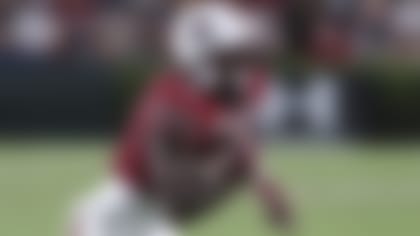The top of the 2018 quarterback class got all the hype. The 2019 class has a chance to be better.
As I prepared to go back and break down some of the key rookie quarterbacks from last season, I expected to be wowed by Kyler Murray's best plays. I did not expect to see Daniel Jones complete even more impressive throws down the stretch, or for Drew Lock to handle the pass rush so well.
Sample-size caveats apply, but this class showed it belonged faster than anyone could have reasonably expected. By the end of last season, that trio mentioned above was putting together better tape on balance than 2018 top-10 picks Baker Mayfield, Sam Darnold and Josh Allen.
The depth of the 2019 class shouldn't be ignored. Jaguars sixth-rounder Gardner Minshew's numbers were the best of the group, and Washington's Dwayne Haskins had some bright moments in the final weeks, but there's only so much column space and time for tape watching in a pandemic. This piece explains why fans of the Giants, Broncos and Cardinals should be quite excited about their future. Here are five enticing aspects of each team's second-year signal-caller:
(Click for Drew Lock breakdown, Kyler Murray analysis)
Daniel Jones is not afraid
1) There is more sizzle to Daniel Jones than you'd expect from a man with that haircut. His best plays pop and there were a lot of them. The Giants' second drive of the Week 13 game against Green Bay, in a driving snowstorm, was the most impressive drive by any of the rookie quarterbacks down the stretch.
If Jones is best thought of as an athletic version of Eli Manning, this drive was his 2011 playoff run. Jones delivered throw after throw despite Packers pass rusher Za'Darius Smith being in his face nearly every play. Jones displays a mix of decisiveness and creativity that's necessary in today's NFL. While his arm is average at best for an NFL starter, the throws he makes below show he has enough to survive. More importantly, he's not afraid to try them.
This Dec. 1 loss to the Packers was instructive when looking at Jones' season. He trusted himself to throw his receivers open, a confidence that led to big plays ... and turnovers. He put together a collection of throws that Aaron Rodgers would be proud of, but it all fell apart with three interceptions.
Jones' turnover tendency must be cleaned up, but context is necessary here. Unlike Eli, Jones was asked to carry a badly flawed team as a rookie. His offensive line had a miserable day and the Giants' defense was one of the worst in the league. Rookie quarterbacks should be judged on a sliding scale, and Jones' attributes showed up faster than most everyone on draft day expected. Of the young quarterbacks I graded, none had more "wow" plays in their final five starts than Jones. That belies his reputation and indicates he has the creativity and chutzpah necessary to survive. Learning how to dial his aggressiveness back should be easier than suddenly growing attributes to play the position that some starters never find.
2) Jones' athleticism is integral to his game. ESPN's QBR ranked Jones as the sixth-most-valuable quarterback as a runner, just ahead of Russell Wilson and Josh Allen. Jones can execute run-pass option plays, but his athleticism is more helpful in buying extra time to make a throw.
Only Sam Darnold was pressured on a higher percentage of plays than Jones last year among qualifiers, according to Pro Football Focus, and the rookie handled it better than his cross-stadium rival. Many of Jones' best plays came after evading the rush with subtle movement or plays outside the pocket, a functional creativity that includes shoulder fakes, pump fakes and a lot of living on the edge.
Jones can get carried away, believing he can make plays that he probably shouldn't try. Like lowering his shoulder to take on 6-foot-5, 265-pound defensive end Preston Smith:
This conversion may fire up his teammates, but it leads me to Jones' biggest red flag ...
3) Jones' biggest strength is a weakness: He's a wild man. Jones is a difficult player to create a comparison for. Athletic Eli works, bigger Ryan Fitzpatrick gets closer and Jameis Winston fits the best if Jones doesn't rein it in a little.
My faulty assumption after Winston's early promising years was that he'd develop into a top-10 quarterback once he reduced his mistakes. That hasn't happened through 70 starts, a path Jones needs to avoid. Jones threw 12 interceptions and fumbled the ball 18 times in only 12 starts. While many of those fumbles happened during the exchange with the center or running back, there were way too many plays where Jones showed poor awareness of the pass rush.
There were also the bad decisions almost any rookie quarterback will make when asked to carry an offense. He'd go through his reads, then malfunction. He'd sometimes see a defender, wait a beat, and still try an impossible throw. Aggressiveness is a great trait, but only if it eventually meets up with maturity. For 2020 to be a success, Jones needs to cut down his Jameis tendencies.
4) The rookie closed strong. It was fun watching Jones because of the obvious progress he made. Asked to throw the ball 39.9 times per game in his final eight starts, he steadily made better decisions and more plays. After sitting out two December games with an ankle injury that conveniently allowed Eli Manning a curtain call, Jones faced an undermanned Washington team in Week 16. For one of the first times all season, he was protected well. He blasted the inexperienced secondary for 28 first-half points and then directed a beautiful game-winning drive in overtime.
Strafing a bad defense when protected is what starting quarterbacks are supposed to do, and Jones looked like a mid-level starter down the stretch. The biggest concern for the 23-year-old quarterback entering 2020 is that his foundation was wiped away. No one believed Pat Shurmur was the future with the Giants, but it's asking a lot for Jones to learn a new offense from Jason Garrett with scant time on the practice field. It's also worth wondering if Garrett is up to the task. It's been a long time since he called plays, and those early Dallas offenses when he was the play caller weren't known for their aggressiveness or creativity.
If nothing else, Garrett figures to increase Jones' play-action snaps. Jones' numbers were far better when using play-action (like most quarterbacks), yet he ranked just 33rd out of 37 qualifiers in percentage of play-action snaps, per PFF. The Giants are also playing under a first-time head coach in Joe Judge, so it wouldn't be surprising to see them struggle early in the season compared to teams with better continuity. The coaching change could mean diminished fantasy numbers for Jones because he has fewer pass attempts, but it still doesn't change my biggest takeaway after watching his games.
5) Daniel Jones looks like a pro. No one knows where Jones' career will go, but he doesn't look like the disaster pick many believed he would be when the Giants took him at No. 6 overall. He looks like an NFL starting quarterback. While teams want more than that out of a top-10 pick, a lot of first-round quarterbacks wind up doing a lot worse than average.
Jones finished 18th as a rookie in ESPN's QBR metric, one spot behind Tom Brady and two spots ahead of Aaron Rodgers. PFF graded him 25th out of 39 qualifiers with at least 150 dropbacks, ahead of guys like Kyler Murray, Sam Darnold, Josh Allen and Mitchell Trubisky. That's closer to where I'd rank his rookie season, which is encouraging. Rookie quarterbacks are impressive if they rent in the neighborhood of average. Jones did that.
A relatively weak arm shows up in his disappointing deep-ball numbers and he's still not Murray or Deshaun Watson as an athlete, so the ceiling here may be borderline top-10 starter. Giants fans grew used to that level of play the last 15 years, and by all accounts, they love it.
Then again, prejudiced evaluations of the local QB is part of the NFL ...
Broncos fans may not be that irrational about Drew Lock
1) Denver fans have earned the right to be overexcited. It's been a challenge for the Football Cognoscenti to fire off a quarterback take this offseason without an orange-and-blue avi jumping into the mentions with some variation of "WHAT ABOUT DREW LOCK?" Pity the writer who suggests a sample size larger than five games is needed before declaring Lock a superstar.
I get it, though. Before Denver snatched up Lock in the second round last year, this was the list of quarterbacks drafted by the franchise since Jay Cutler: Tom Brandstater, Tim Tebow, Brock Osweiler, Zac Dysert, Trevor Siemian, Paxton Lynch and Chad Kelly. The Peyton Manning era was beautiful, but it's been a long time since the Broncos have had a promising young quarterback to call their own. And those five games were enough for an unbiased observer to jump on board.
I was ambivalent about Lock's short stint before re-watching all of his snaps. The schedule was favorable and his best box-score game was largely the product of disastrous Texans defense. Beyond the numbers, however, were a lot of impressive traits. Broncos GM John Elway still would have been better off signing a legitimate veteran backup when they were so cheap this offseason, but Lock earned Elway's trust in December.
2) Lock was a revelation under pressure. Explaining away Lock's success by his schedule doesn't hold up under scrutiny when you watch the games or examine the numbers. The poor defenses that Lock faced were still better than the lousy Broncos offensive line. Out of 39 PFF qualifiers, Lock faced pressure at the 14th-highest rate per dropback despite an offense with virtually no vertical passing element. Yet no quarterback in the entire NFL had a lower sack rate per pressure than Lock. Yep, he was even better at avoiding sacks than veterans allergic to hitting the ground like Drew Brees, Tom Brady and Aaron Rodgers.
This trait showed up on tape repeatedly. Lock's offensive line lost quickly and he'd avoid negative plays by scrambling, dumping the ball off or throwing it away.
A quarterback's athleticism is only valuable if he has the instincts to use it well. Even if Lock's knowledge of the playbook and protection schemes was lacking, he kept his offense on schedule like a veteran. In situations where Joe Flacco would take sack after sack, Lock made something happen or avoided something terrible happening. It's one of the toughest traits for a quarterback to learn and could be a huge part of Lock's repertoire if it sticks.
3) Lock made his teammates better. Rookie quarterbacks stand out just by blending in. Lock did more than that, improving the players around him after 11 games of lackluster quarterback play.
The offensive line is the most obvious group that looked better with Lock behind center, but the big guys weren't alone. Tight end Noah Fant played like a future Pro Bowler after Lock took over. Little-used receiver DaeSean Hamilton became a consistent producer in the final weeks. Lock's mobility unlocked some creativity in the Broncos' running game, while the line had to appreciate all those sacks he avoided. Two of the three best Broncos performances in offensive efficiency (Football Outsiders' DVOA metric) came during Lock's short run. While they came against lackluster defenses, it's not like Denver didn't play plenty of mediocre defenses in the first 11 weeks. Lock was the biggest difference in the results.
4) But what about that schedule? The two best defenses that Lock faced were the Chargers and Chiefs, both mediocre outfits. He didn't play particularly well in either game, including one in the snow in Arrowhead where Lock made some amazing throws early before transitioning to full rookie "screw it" mode in the second half.
If you are inclined to doubt Lock's 2019 five-game sprint, there are better areas to question than the schedule. There was a lot of confusion and wristband checking while he learned the Broncos' offense, something to keep in mind as he tries to learn another new system without much practice time this year. Denver is strangely confident that coordinator Pat Shurmur is going to be Lock's Sean McVay despite a decade-plus of mediocre results from Shurmur's passing games. Lock's starts were the first time all year the Broncos' offense made sense and now they have to start over.
Lock also had a tendency to drift in the pocket, his footwork sometimes hurting his accuracy. The fact that he struggled to go through his reads quickly -- if at all -- was typical for a rookie, but that spells out just how new this entire Broncos offense will be in 2020. Lock will be learning a new system alongside Fant and rookie receivers Jerry Jeudy and KJ Hamler. Elway said he's tempering expectations for his rookies, which sounds about right during a pandemic. Few teams should be hurt more by the lack of practice time before the season than Denver, which is so lacking in veterans. The Broncos are putting a lot on their talent -- starting with Lock's gifts -- to carry them, because it's unlikely they are going to have a schematic advantage.
5) Seriously, those tools. Amazing throws are amazing throws, no matter which team they come against. Lock's pure arm strength ranks among the 10 best in football. His pretty throws, often deep outs, are particularly pretty. I'm susceptible to falling for style points from players with big arms -- Hello, Jay Cutler!! -- but Lock's mixing of speeds was a great sign. Many of his best throws were over routes where he showed deft touch. His short and intermediate passes were too solid to validate the Blake Bortles comp that one Lock doubter hit me with.
If anything, the Broncos didn't use Lock's arm enough. Among QBs who started at least four games, only Jimmy Garoppolo threw deep (20-plus yards in the air, per PFF) last season on a smaller percentage of passes than Lock. That was partly because of Denver's quick-throw scheme and poor pass protection, which Lock mitigated with his creativity. Making something out of nothing is a prerequisite for young NFL quarterbacks, and Lock's arm strength helped him create on the move plenty. He can throw from a variety of arm angles and made a number of quality throws while on the move to his left, usually the toughest pass for a right-hander.
The tools are there. Lock and his coaches just need to figure out how to use them, which they did a better job of in his last two starts against the Lions and Raiders. The Detroit game was a great litmus test because it was the one full game in which he was protected well. I graded it as his best game by far, as did PFF. In fact, Lock ended up with the best average grade in his last five starts of any rookie or second-year quarterback that I studied this offseason. (Lamar Jackson was notably not included.)
Taking advantage of spotless protection doesn't make a quarterback special, but it is a prerequisite to have a long career as a starter. The trail of failed Broncos quarterback prospects wouldn't have thrived so early in that situation, much less in all the other ugly spots Lock was placed in during his five-game rehearsal. Who can blame Denver fans for dreaming -- and online screaming -- about what Lock could accomplish when he gets more help?
As exciting as Lock was, his ceiling remains lower than our last QB up for discussion ...
Kyler Murray is not Lamar Jackson or Patrick Mahomes, and that's OK
1) Murray's great games as a rookie were so great that 2020 expectations may be unrealistic. Murray has become a trendy MVP sleeper pick, with only seven players ahead of him according to some desert odds. That puts Murray on the same level as Carson Wentz and Aaron Rodgers, which is the deep end of the NFL's talent pool. That's asking a lot.
Mahomes and Jackson won MVPs in their second seasons, so it's natural to look for the next big thing. Murray qualifies, as an ultra-talented No. 1 overall pick who put up impressive numbers as a rookie. It's just worth remembering that it's a huge success for any second-year quarterback to be a top-10 starter, much less the best. Based just on his rookie tape, Murray understandably still has a long way to go.
This is not to diminish what Murray accomplished last season. His best games -- against the 49ers and Browns -- were sensational. His combination of pinpoint deep throws and electric running ability could eventually help him look like a hybrid of Mahomes, Jackson and Russell Wilson. Expecting him to become that player in his second season feels unfair, however, because it'd be unfair to anyone.
2) The running game starts it all. A funny thing happened while Kliff Kingsbury brought the "Air Raid" offense to the pros: His running game dominated. The Cardinals finished second in rushing efficiency (DVOA) last season and 20th in passing efficiency, both remarkable improvements from the team's futile 2018 offensive effort (31st in rushing efficiency, 32nd in passing efficiency). Murray was the key to it all.
Murray finished fourth in rushing value among quarterbacks, according to QBR, and ninth by PFF's count. Defenses sold out to keep Murray in the pocket by the end of the season, but he was still deadly when executing run-pass options. Kingsbury's offense naturally spreads the opposition out, allowing big running lanes. After some hesitancy early, Murray wound up with 544 yards rushing. He is excellent at avoiding big hits and making defenders miss. He will learn when best to run with more experience.
While Murray may be the most naturally gifted running quarterback in the league behind Jackson, his decision-making was typical of a rookie. The Football Outsiders Almanac recorded 15 sacks from Murray that came off failed scrambles; no other team had more than 10. Too often, Murray made a decision to run on third-and-long only to come up short; on other occasions, he passed up an easy running first down to force a throw. That decision-making will improve with more reps, but it's also fair to say Murray didn't always show the instincts on when to run like Jackson or a rookie version of Cam Newton. Unlike them, Murray will likely do most of his damage from the pocket.
3) Murray's deep ball is art. If Murray were a baseball pitcher, he'd have easy heat. The natural way he can throw the ball 40 yards to the opposite hashmark with minimal apparent effort is a sight to behold. He completed a number of passes more than 50 yards on a dime. PFF records deep passes, where Murray averaged 15.22 yards per attempt on throws targeted at least 20 yards down the field. That ranked in the top five of all quarterbacks, just ahead of vertical maestros like Wilson, Dak Prescott and Deshaun Watson.
Murray throws deep with such panache that it's safe to assume it will become a bigger part of Arizona's offense. Murray threw the ball fewer times per dropback than average, which may partly have to do with his relatively poor offensive line and weapons around him last season. He was also piloting an offense with a rookie coach who was finding his way in the NFL.
The 2019 Cardinals' offensive approach -- strong running game supported by deep shots -- looked like a recipe from the 1980s, but how Arizona accomplished it was very different than NFL norms.
4) The Cardinals' offense remains a grand experiment. The narrative that took hold late last season centered around Kingsbury going away from his four-receiver packages and finding religion in tight ends. While that was true to an extent, Football Outsiders notes that the Cards still used four receivers on a third of all their plays. No other team topped 8 percent! Arizona ran no-huddle more than any team in the league, used an empty backfield more than any team and lined up in the shotgun 88 percent of the time, second in the NFL.
These trends often made Murray difficult to evaluate. One reason why PFF may have ranked Murray 29th among starters entering this season -- and 32nd out of 39 qualifiers last season -- was the relative lack of traditional throws. So many of Murray's passes were quick, short, first-read tosses. This is how the offense is designed. But it makes it difficult to separate scheme from the player. When the first read wasn't there, Arizona's passing game often went sideways. The team's numbers against the blitz were dreadful.
Murray has spoken about taking too many sacks last year, a league-leading 48. In addition to the failed scrambles mentioned above, there were a lot of coverage sacks and plays where Murray held on to the ball too long. This is a trait he can be coached out of. In a strange way, I was impressed how comfortable Murray seemed just bouncing on his feet in the pocket, waiting for a play to develop. He wasn't antsy; he often just waited too long. In 2020, he may find receivers open more quickly because ...
5) The Cardinals offense should be a lot better. DeAndre Hopkins makes quarterbacks better. Just ask Deshaun Watson, Case Keenum, Ryan Fitzpatrick, Brian Hoyer and even Brock Osweiler. Murray's deep ball combined with Hopkins' specialty winning deep contested catches should be as lethal as, well, Watson-to-Hopkins.
Kingsbury ironed out the kinks in his offense last season, and the Week 1 presence of running back Kenyan Drake -- acquired in a midseason trade last year -- should bolster the running game. Third-year pro Christian Kirk fits in well as a No. 2 option behind Hopkins, with Larry Fitzgerald manning the slot and youngsters Andy Isabella and KeeSean Johnson a year more experienced in Kingsbury's system.
Murray only needs steady progress to become an above-average starter at age 23, a huge accomplishment in this incredibly deep era of quarterbacks. (And something Baker Mayfield and Sam Darnold were not last year.) Murray is still the Class of 2019 quarterback I'd take for the rest of his career because of his skill set, and it's not that close. It's just unrealistic to expect him to suddenly skip all the stages of development that, say, Russell Wilson went through.
After we all got too excited about Mayfield coming off his rookie season, it just feels premature to declare Murray the next great heir to the QB throne. The gap in performance between Murray and the rest of his 2019 QB class was not as great as I initially believed, which is no slight to the reigning Offensive Rookie of the Year. It's a sign that Murray's not the only second-year signal-caller who could eventually emerge as a top-10 starter; his classmates, Daniel Jones and Drew Lock, share that potential.
Follow Gregg Rosenthal on Twitter @greggrosenthal.













